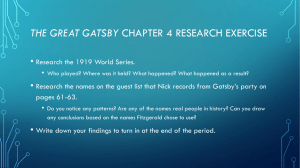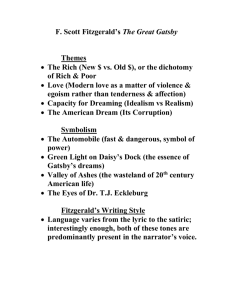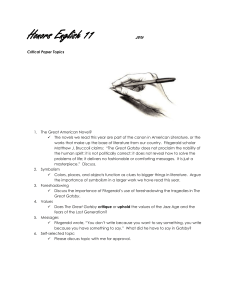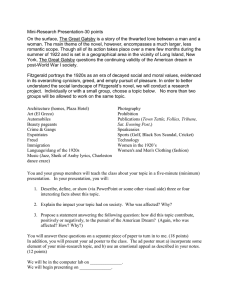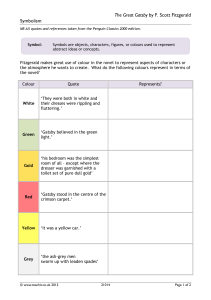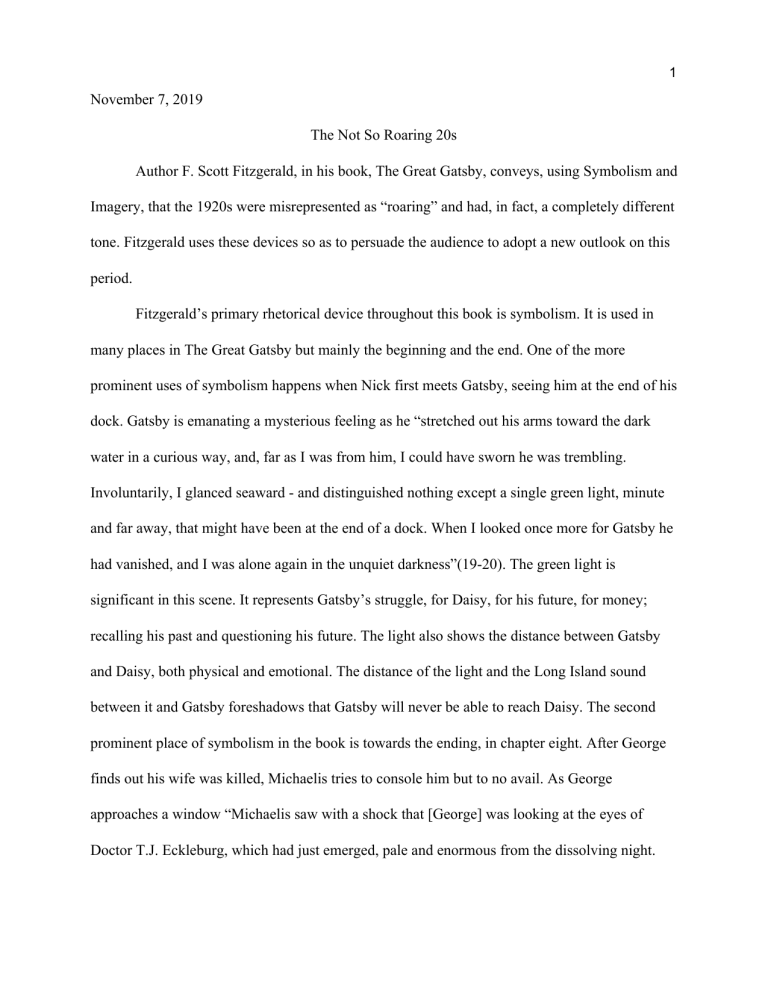
1 November 7, 2019 The Not So Roaring 20s Author F. Scott Fitzgerald, in his book, The Great Gatsby, conveys, using Symbolism and Imagery, that the 1920s were misrepresented as “roaring” and had, in fact, a completely different tone. Fitzgerald uses these devices so as to persuade the audience to adopt a new outlook on this period. Fitzgerald’s primary rhetorical device throughout this book is symbolism. It is used in many places in The Great Gatsby but mainly the beginning and the end. One of the more prominent uses of symbolism happens when Nick first meets Gatsby, seeing him at the end of his dock. Gatsby is emanating a mysterious feeling as he “stretched out his arms toward the dark water in a curious way, and, far as I was from him, I could have sworn he was trembling. Involuntarily, I glanced seaward - and distinguished nothing except a single green light, minute and far away, that might have been at the end of a dock. When I looked once more for Gatsby he had vanished, and I was alone again in the unquiet darkness”(19-20). The green light is significant in this scene. It represents Gatsby’s struggle, for Daisy, for his future, for money; recalling his past and questioning his future. The light also shows the distance between Gatsby and Daisy, both physical and emotional. The distance of the light and the Long Island sound between it and Gatsby foreshadows that Gatsby will never be able to reach Daisy. The second prominent place of symbolism in the book is towards the ending, in chapter eight. After George finds out his wife was killed, Michaelis tries to console him but to no avail. As George approaches a window “Michaelis saw with a shock that [George] was looking at the eyes of Doctor T.J. Eckleburg, which had just emerged, pale and enormous from the dissolving night. 2 ‘God sees everything,’ repeated [George]”(159-160). George himself speculates that the eyes signify God. In George’s mind, the eyes are an indication of God, looking down on the American people with disapproval. Fitzgerald, using this billboard shows that even God is discontent at the state of the nation in this time. The billboard looms over the valley of ashes and watches over everyone. Not only using these examples but also other ones, Fitzgerald successfully conveys the state of the nation during the 1920s. Another important rhetorical device used by F. Scott Fitzgerald is Imagery. Imagery is used to convey to the reader, the feeling of the 20s; what it was like to live there, among the poor, who were forced to help the rich increase their wealth. One such example of this is the Valley of Ashes, a place where many of the poorest citizens work. During his first trip to New York, Nick describes it as “a fantastic farm where ashes grow like wheat into ridges and hills and grotesque gardens; where ashes take the forms of houses and chimneys and rising smoke and, finally, with a transcendent effort, of men who move dimly and already crumbling through the powdery air”(23). His description is full of words with negative connotations such as “grotesque”,”dimly” or “crumbling”. These words enhance Fitzgerald’s description of the 1920s and allow the audience to better understand the lifestyle of the poor and how horrible it was, compared to the rich. Fitzgerald used this to show the large divide between the social and economic classes of that time period. Another powerful imagery example is used in chapter 9. After Gatsby’s death, Nick attempts to call and convince as many people as he can to come to Gatsby’s funeral, but to no avail. After the funeral started at 5PM, “our procession of three cars [reaches] the cemetery and [stops] in a thick drizzle beside the gate - first a motor-hearse, horribly black and wet, then Mr. Gatz and the minister and I in the limousine, and a little later 3 four or five servants and the postman from West Egg, in Gatsby’s station wagon, all wet to the skin. As we [start] through the gate into the cemetery I [hear] a car stop and then the sound of someone splashing after us over the soggy ground”(174). After Gatsby’s death it was almost as if his mass of followers disappeared. Once he was gone and his fortune disappeared, Gatsby was no longer relevant to them. It was money that almost everyone that attended his parties was after. Fitzgerald conveys this lonely mood, similar to the valley of ashes description, using words that have a negative connotation such as “thick drizzle” or “horribly black” These descriptions allow the reader to visualize Gatsby’s funeral and feel sympathy for him. Fitzgerald successfully demonstrates the 1920s were misrepresented. Even though F. Scott Fitzgerald’s work is famous today, after release in the 1920s, the book had almost no impact on society. Most people completely disregarded the book and considered Fitzgerald as a “one hit wonder” and a “failed writer”. However, after the book was re-released during World War II, it gained popularity massively and started to be read in schools nationwide. Because it was widely criticized by it’s target audience, the people of the 1920s, Fitzgerald failed in his original purpose; to change the lifestyle of the people during the 1920s but succeeded in a purpose, that was unseen by him; to educate future generations about the horrible quality of life and the divide between the socio-economic classes during this time period. Because of this, The Great Gatsby i s today widely regarded as one of the greatest American pieces of literature. 4 Works Cited Fitzgerald, F. Scott. The Great Gatsby. Scribner, 2018.
